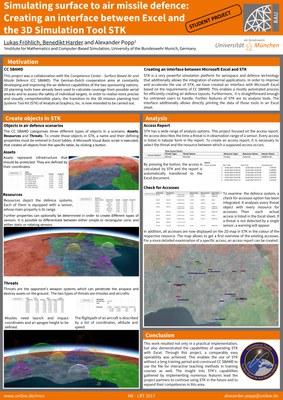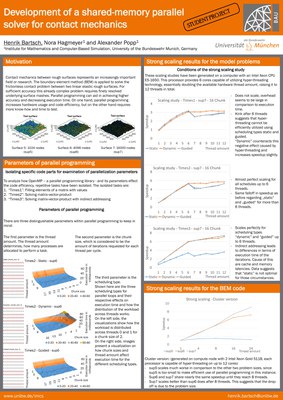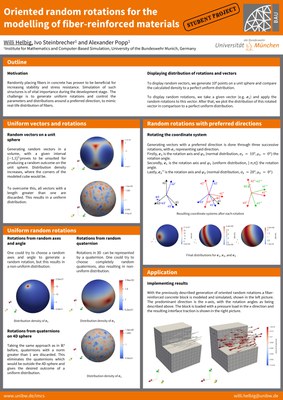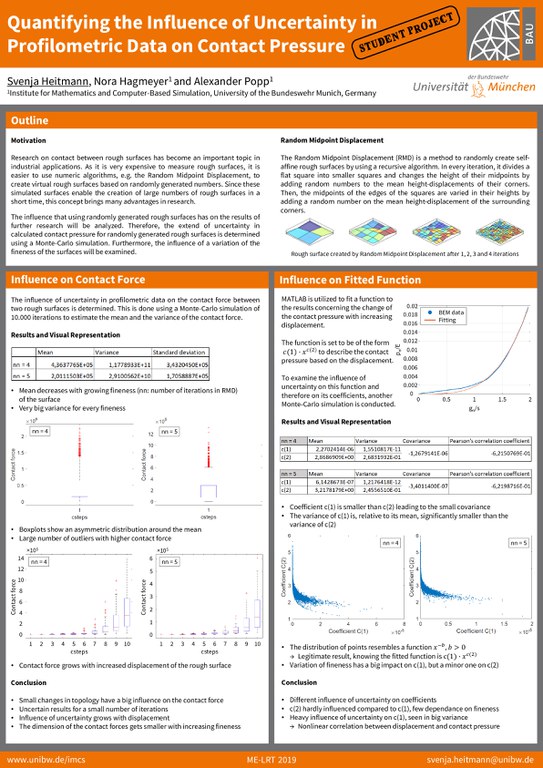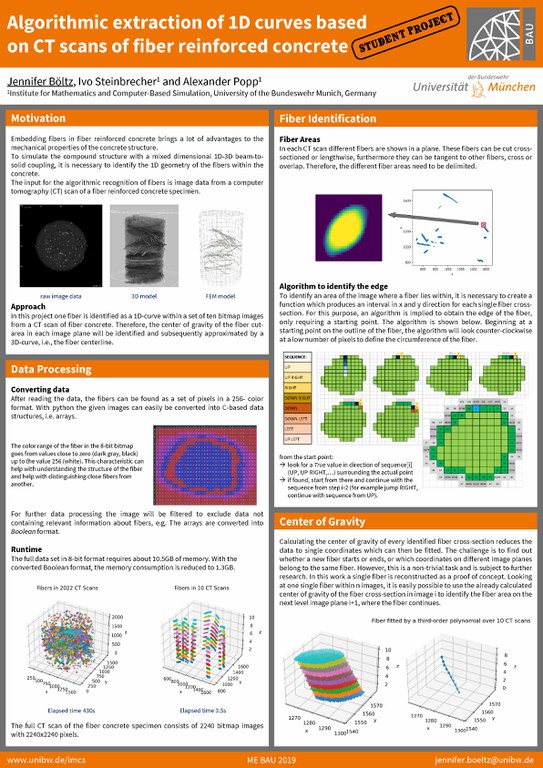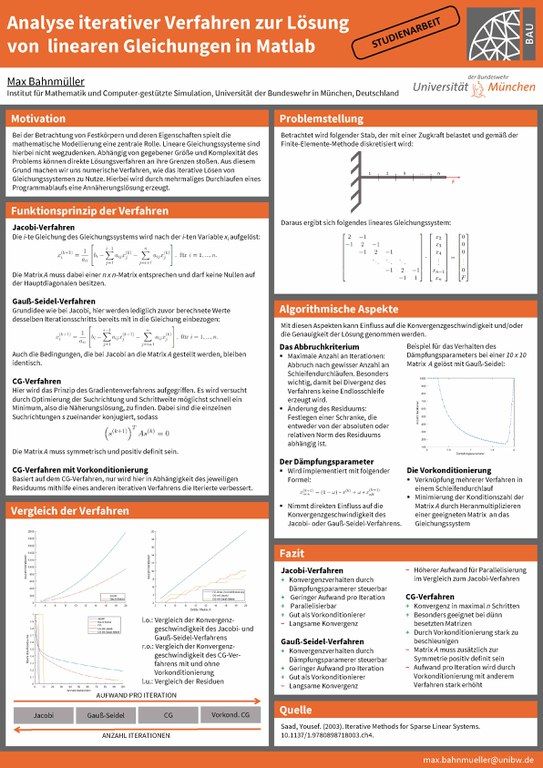General Information
IMCS offers a wide range of opportunities for students of civil and environmental engineering and mathematical engineering to write their final theses (bachelor and master) as well as study projects at our institute. Students work closely with the scientific staff of the institute, always within the framework of current research topics in the fields of mathematics and computer-aided simulation. This gives students valuable insights into engineering work and best chances for their future career.
Examples
Modelling and simulation of fiber-reinforced conctrete based on real 3D-CAT-Scans (Master Thesis BAU, 2020 – Dao Viet Anh)
For the modeling and simulation of fiber reinforced concrete, a realistic spatial distribution of the fibers is essential for the quality of the numerical results. The aim of this work was to use the real fiber geometry of a specimen obtained with a CAT to create a finite element model of that specimen. The fibers were modeled as 1D beams and the concrete as a 3D continuum and connected with coupling algorithms developed at IMCS. The results confirm that the position of the fibers is essential for their reinforcing effect and, especially in fiber-reinforced concrete, care must be taken to ensure that the fibers do not arrange themselves in unwanted clusters.
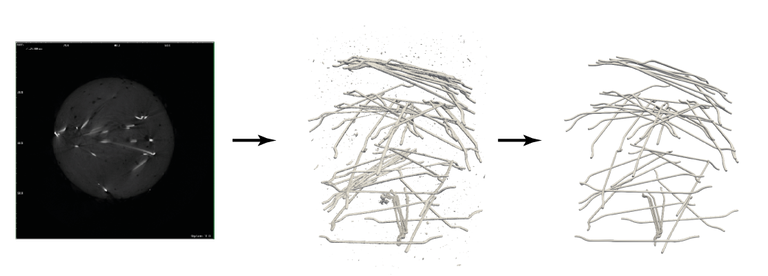
Oriented random rotations for the modelling of fiber-reinforced materials
(Student research project, 2020 - Willi Helbig)
For the modeling and simulation of fiber-reinforced materials, a realistic spatial distribution of the fibers is essential for the quality and usability of the numerical results. In real materials, however, the fibers are usually not evenly distributed, but have a preferred direction. This may be the case due to manufacturing restrictions or targeted improvement of material properties. This student research project investigated the creation of these random orientations along a preferred direction. For this purpose a specially developed parallel software for Monte Carlo simulation of the rotations was successfully employed, and run on the institute's own High Performance Computing (HPC) cluster.

Poster von Studien- und Projektarbeiten
Interested?
If you are interested, depending on the desired focus of the student project, please contact directly
- Prof. Thomas Apel (Mathematics) or
- Prof. Alexander Popp (Computer-Based Simulation).
List of Completed Student Projects
M.Sc. Theses:
| Isogeometrische Simulation der Eigenfrequenzen von Rissgebieten mittels verfeinerter Netze und Anwendung zur Rissidentifizierung (2023) |
| Mortar monolithic block systems and preconditioners in fluid-structure interaction (2023) |
| Comparison of Constraint Enforcement Strategies for Immersed Finite Element Methods (Master thesis with the University of Colorado Boulder, 2020) |
| Modeling a Stented Artery using geometrically Exact Beam Theory (Master's thesis with Technical University Munich 2022) |
| Generalized Nitsche and Penalty contact constraint enforcement in the context of immersed hierarchical B-Splines (Master thesis with the University of Colorado Boulder, 2020) |
| Modellierung und Simulation von faserverstärktem Beton anhand realer 3D-Computertomografie-Scans (2020) |
| Numerisches Lösen eines Optimalsteuerproblems mit dem vereinfachten Signorini-Problem als Nebenbedingung (2020) |
| Finite-Elemente-Netze ohne Maximalwinkelbedingung in dreidimensionalen Gebieten (2020) |
| Berechnung von Eigenschwingungsformen von Platten mittels FEM (2019) |
| Investigation of Heterotic String Vacua using Gauged Linear Sigma Models (Masterarbeit mit LMU, 2012) |
| Datenreduktion für Large Scale Klassifikations-Probleme (Masterarbeit bei Cassidian, 2012) |
| Calculation of the Temperature Field in Welding with a Pulsed Power Source (Masterarbeit mit Linde AG, 2011) |
| Optimale Steuerung der Dirichlet-Randdaten - Finite-Elemente-Diskretisierung und Implementierung (2011) |
| Berechnung zur Energieeffizienzbewertung von Gebäuden (2011) |
| Numerische Lösung der Navier-Stokes-Gleichungen: Verifikation einer 2D-Lösung (2011) |
| Eine adaptive stabilisierte Finite-Elemente-Methode für ein Diffusions-Konvektions-Reaktions-Problem (Diplomarbeit 2008) |
| Numerische Simulation Regen-Wind induzierter Seilschwingungen (Diplomarbeit 2006) |
B.Sc. Theses:
| Evaluation of a geometric search algorithm for mixed-dimensional modeling approaches (2024) |
| Implementierung von Physik-Informierten Neuronalen Netzen in der Elastizitätstheorie under Verwendung 2D-Rechengebieten (2022) |
| Simulationsgestützte Machine Learning-Ansätze zur Vorhersage der maximalen Durchbiegung eines Träger (2021) |
| Implementation of truss elements inside the DUNE framework (2021) |
|
Implementing the finite element method for quantum graphs (2021) |
|
Algebraische Mehrgitterverfahren für torsionsfreie Kirchhoff-Love Balken (2021) |
|
Adaptive Interpolation von Funktionen mittels neuronaler Netze (2021) |
| Untersuchung von nicht form-regulären finiten Elementen (2019) |
| Modellierung von Balken-, Festkörper-Interaktionen mit der Finite-Elemente-Methode (2018) |
| Bestimmung kritischer Zeitschrittweiten in Struktur-Simulationen (2018) |
| Lösung eines elliptischen Randsteuerproblems (2018) |
| Finite-Elemente-Lösung einer Randwertaufgabe mit nichtglatter Randbedingung (2018) |
| Auswahl eines Netzgenerators zur Kopplung mit FEniCS (2015) |
| FEM-Lösung ausgewählter quasilinearer partieller Differentialgleichungen mit Fokus auf Existenz und Eindeutigkeit (2014) |
| Experimentelle und numerische Analyse dreidimensionaler instationärer Rohrströmungen (2014) |
| An optimised algorithm for the determination of solar array rotation profiles for temperature critical missions (with Astrium, 2013) |
| Implementierung eines Programms zur anisotropen Netzverfeinerung (2013) |
| Bestimmung der beidseitigen Randkonturen von Schleppkurvenflächen mehrgliedriger Fahrzeuge (2011) |
| Computation of the resistance of a cracked electrical conductor (at ENSTA Paris, 2010) |
| Implementierung eines Netz-Managers für 3D Finite-Elemente-Netze (2011) |
| Approximation der Brennphase ungelenkter Raketen (mit Eurocopter, 2010) |
| Generierung eines speziellen dreidimensionalen Finite-Elemente-Netzes (2010) |
| Berechnung von Temperaturspannungen während der Hydratation von Beton (2009) |
| Vergleich von Zeitintegrationsverfahren für parameterinduzierte Seilschwingungen (2009) |
Student research projects:
|
Vergleich von Glättern für die Mehrgitter-Vorkonditionierung in der Fluid-Struktur-Interaktion (2023) |
|
Vergleich von Modellen zur Approximation der Eigenfrequenzen dünner Platten (2023) |
|
Generation of surfaces and extrusion of 2D meshes for isogeometric analysis with B-splines / NURBS (2022) |
|
Quantifying the influence of uncertainty in profilometric data on the contact pressure between rough surfaces (2021) |
| Simulation of ground-based air defense - Setting up an interface between Microsoft Excel and AGI STK (with CC SBAMD, 2021) |
| Development of a shared-memory parallel solver for contact mechanics of rough surfaces (2020) |
| Oriented random rotations for the modelling of fiber-reinforced materials (2020) |
| Implementierung eines a-posteriori Fehlerschätzers für die Stokes Gleichungen (Projektarbeit ME 2019) |
